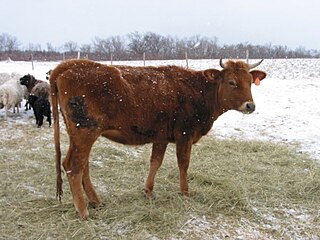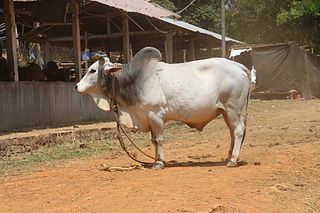Related Research Articles

The zebu, sometimes known in the plural as indicine cattle or humped cattle, is a species or subspecies of domestic cattle originating in the Indian sub-continent. Zebu are characterised by a fatty hump on their shoulders, a large dewlap, and sometimes drooping ears. They are well adapted to withstanding high temperatures, and are farmed throughout the tropical countries, both as pure zebu and as hybrids with taurine cattle, the other main type of domestic cattle. Zebu are used as draught and riding animals, dairy cattle, and beef cattle, as well as for byproducts such as hides and dung for fuel and manure. Some small breeds such as the miniature zebu are also kept as pets. In 1999, researchers at Texas A&M University successfully cloned a zebu.

The Jersey is a British breed of small dairy cattle from Jersey, in the British Channel Islands. It is one of three Channel Island cattle breeds, the others being the Alderney – now extinct – and the Guernsey. It is highly productive – cows may give over 10 times their own weight in milk per lactation; the milk is high in butterfat and has a characteristic yellowish tinge.

The Brahman is an American breed of zebuine-taurine hybrid beef cattle. It was bred in the United States from 1885 from cattle originating in India, imported at various times from the United Kingdom, from India and from Brazil. These were mainly Gir, Guzerá and Nelore stock, with some Indu-Brasil, Krishna Valley and Ongole. The Brahman has a high tolerance of heat, sunlight and humidity, and good resistance to parasites. It has been exported to many countries, particularly in the tropics; in Australia it is the most numerous breed of cattle. It has been used in the creation of numerous taurine-indicine hybrids, some of which – such as the Brangus and Brahmousin – are established as separate breeds.

The Guernsey is a breed of dairy cattle from the island of Guernsey in the Channel Islands. It is fawn or red and white in colour, and is hardy and docile. Its milk is rich in flavour, high in fat and protein, and has a golden-yellow tinge due to its high β-carotene content. The Guernsey is one of three Channel Island cattle breeds, the others being the Alderney – now extinct – and the Jersey.

The Ayrshire is a Scottish breed of dairy cattle. It originates in, and is named for, the county of Ayrshire in south-western Scotland. Ayrshires typically have red and white markings; the red can range from a shade of orange to a dark brown.

The Alderney is an extinct breed of dairy cattle. It originated in, and is named for, the island of Alderney in the Channel Islands. It was one of three breeds of Channel Island cattle, the others being the Jersey and the Guernsey. In the eighteenth and nineteenth centuries "Alderney" was a general term for cattle from the archipelago; many were exported to mainland Britain under this name, regardless of which of the islands they came from.

The Gir or Gyr is one of the principal Zebu breeds originating in India. It has been used locally in the improvement of other breeds including the Red Sindhi and the Sahiwal. It was also one of the breeds used in the development of the Brahman breed in North America. In Brazil and other South American countries the Gir is used frequently because, as a Bos indicus breed, it is resistant to hot temperatures and tropical diseases. It is well known for its milk producing qualities and is often bred with Friesian cows to make the Girolando breed.

Red Sindhi cattle are the most popular of all Zebu dairy breeds. The breed originated in the Sindh province of Pakistan, they are widely kept for milk production across Pakistan, India, Bangladesh, Sri Lanka, and other countries. They have been used for crossbreeding with temperate (European) origin dairy breeds in many countries to combine their tropical adaptations with the higher milk production found in temperate regions. It has been crossed with Jerseys in many places, including India, the United States, Australia, Sri Lanka, etc.

Polled livestock are livestock without horns in species which are normally horned. The term refers to both breeds and strains that are naturally polled through selective breeding and also to naturally horned animals that have been disbudded. Natural polling occurs in cattle, yaks, water buffalo, and goats, and in these animals it affects both sexes equally; in sheep, by contrast, both sexes may be horned, both polled, or only the females polled. The history of breeding polled livestock starts about 6000 years BC.
The German Black Pied Dairy was a dairy cattle breed of the former GDR, created through combination breeding.

Canadienne cattle, also known as Black Canadienne, French Canadienne, and Black Jersey, are the only breed of dairy cattle developed in Canada. They originated in the 16th century, when French settlers brought cattle over for foundation stock to settle Canada. The Canadienne were the most common breed of domestic cattle in Canada until the late 19th century, when other breeds began to displace them. Today, the Hereford and Holstein have become the most common types of cattle in Canada. The Canadienne, though still found on farms and ranches across the nation, is now comparatively rare except in certain areas of the province of Quebec. Efforts by an active breed society and the Quebec government have been made in recent years to preserve the breed from extinction.
Jamaica Hope is a dairy breed of cattle originating from Hope Farm in Jamaica.
Miniature cattle are found in various parts of the world. Some, such as the Dexter of Ireland and the Vechur of Kerala, India, are traditional breeds; others have been recently created by selective breeding. The Australian Lowline was the unexpected result of a scientific experiment. Some, but not all, miniature breeds display achondroplasia, or dwarfism.
In Sri Lanka many farmers depend on animal husbandry for their livelihood, but not a large proportion. Therefore, many livestock products have to be imported. The main livestock products in Sri Lanka are milk, meat and eggs. Hides, wools and other products are still not produced within the country. Animal power formerly used in the cultivation of rice and vegetables have been replaced by modern technology to farmlands. However animal husbandry plays an important role in the rural economy for improving the living conditions of farmers in the country.

The Malvi or Malavi, also known as Manthani or Mahadeopuri, is breed of zebu cattle from the Malwa plateau in western Madhya Pradesh, in central India. It is a good draught breed; the milk yield of the cows is low.

Punganur dwarf cattle which originated from the Chitoor District of Andhra Pradesh in southern India is among the world's smallest humped cattle breeds. The Punganur breed's milk has a high fat content. While cow milk normally has a fat content of 3 to 3.5 per cent, the Punganur breed's milk contains 8 per cent.

Ongole cattle is an indigenous cattle breed that originates from Prakasam District in the state of Andhra Pradesh in India. The breed derives its name from the place the breed originates from, Ongole. The Ongole breed of cattle, Bos indicus, has a great demand as it is said to possess resistance to both foot and mouth disease and mad cow disease. These cattle are commonly used in bull fights in Mexico and some parts of East Africa due to their strength and aggressiveness. They also participate in traditional bull fights in Andhra Pradesh and Tamil Nadu. Cattle breeders use the fighting ability of the bulls to choose the right stock for breeding in terms of purity and strength. The mascot of the 2002 National Games of India was Veera, an Ongole Bull.

Hariana or haryanvi is an Indian breed of cow native to North India, specially in the state of Haryana. They produce about 10 to 15 litres of milk a day, compared to 8.9 litres when cross-bred with Holstein Friesian cattle (HS), whereas pure HS can produce 50 litres a day, but it is not as disease-resistant in the conditions of North India.

The Dutch Belted or Dutch Belt is an American breed of dairy cattle. It derives from the Lakenvelder of Germany and the Netherlands, of which examples were imported to the United States from 1838. It became an important dairy breed in the early twentieth century, but could not compete with the Holstein-Friesian. By 1970 it was close to extinction; from 1993 the American Livestock Breeds Conservancy was active in the recovery of the breed. In 2021 it was listed as "critical" on the watchlist of the conservancy.
References
- ↑ Chacko, C.T. "Development of the Sunandini cattle breed in India". FAO. Retrieved 21 April 2016.